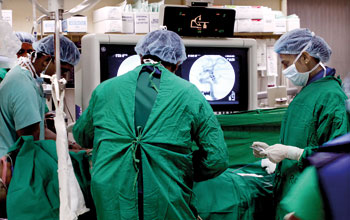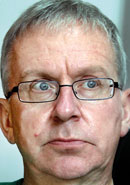Stents in the heart are common in Sri Lanka but what of stents in the brain?
He waited in agony, death always hovering by his side. Will it, won’t it, the 59-year-old worried, hoping and praying it won’t. His fears were justified, for he was carrying a heavy burden in his brain – a very large aneurysm in the internal carotid artery which had led to the closure of the eyelid and visual symptoms (ptosis), the rupture of which would have a significant risk of immediate death.
On July 26, his fears were laid to rest and he became one of three “pioneering patients” to undergo stent-assisted coiling sans the opening of his skull, the Sunday Times found.
Stents in the brain, this first-ever procedure in the country has now been established at the National Hospital’s Division of Interventional Radiology under Dr. Nihal Wijewardena, Consultant Interventional Radiologist, with Senior Registrar Dr. Lakmalie Paranahewa who has come back for a short stint from England performing the stent-assisted coiling.
A multidisciplinary team, along with Dr. Paranahewa, performed these procedures, with the support and expertise of NHSL’s Neurosurgical as well as Neuroanaesthetic teams who have been encouraging them in their task.
The procedures were part of a workshop arranged by the Division of Interventional Radiology, with Senior Registrar Dr. Radhika Karunarathna, other doctors, nurses, radiographers and minor staff participating.
Observing the procedure intently, when the Sunday Times was at the Division of Interventional Radiology was also Consultant Neuro-radiologist Dr. Paul Butler of Bart’s and the London National Health Service Trust of the United Kingdom.
Dr. Butler is not only Dr. Paranahewa’s senior in England but also has “many hundreds” of such procedures to his credit. (See box)
| Next step: Mechanical clot-retrieval |
The sights are set on ‘mechanical clot-retrieval’ from the brain to reverse the devastating impact of stroke now that stent-assisted coiling for aneurysms has taken shape at the National Hospital.
Here too a stent is used for clot retrieval, but unlike in stent-assisted coiling, the device is removed along with the clot in contrast to the other procedure where the stent is detached and left within the vessel. In clot retrieval, the stent is deployed in the vessel distal to the clot but not detached, and retrieved with the clot, explains Dr. Paranahewa.
The Division of Interventional Radiology will work in tandem with the Institute of Neurology where the multidisciplinary team at the far-thinking Stroke Unit headed by Consultant Neurologist Dr. Padma Gunaratne has done much to save lives.
Whenever, the Stroke Unit requests our assistance in selected cases, especially if the stroke victim has come in late, we could support them with the mechanical clot retrieving procedure, said Dr. Paranahewa, explaining that while the golden window for the administration of a clot-buster is about three hours, the retrieval has slightly more leeway in the form of double that time or six hours.
It was this very important topic of “interventions” that Dr. Paul Butler dealt with at length at the Symposium on Management of Acute Stroke at the annual academic sessions of the Sri Lanka College of Radiologists in the last week of July. |
“There was no other way to tackle this large 6x10 mm aneurysm with a wide neck that was too big to simply coil, explains Dr. Paranahewa, taking a short breather in her busy schedule to talk to the Sunday Times.
A ruptured aneurysm needs urgent attention as it causes a subarachnoid haemorrhage (bleeding in the area – subarachnoid space -- between the brain and the thin tissues that cover the brain). One-third of the patients with a ruptured aneurysm die before reaching the hospital. In the others, it is crucial to pre-empt a re-bleed as it has a higher risk of death and the critical period of a re-bleed is 10 days, the Sunday Times understands.
Unruptured aneurysms are yet a controversial topic and should be treated depending on their size, morphology (form and structure) and other risk factors (high blood pressure, family history etc) of the patient, it is learnt.
When the neck of the aneurysm is wide, it is difficult to perform simple coiling maintaining the patency of the vessel and stents are used to keep the main vessel open, points out Dr. Paranahewa.
Explaining what an aneurysm is before delving into how it is repaired with the use of the Digital Subtraction Angiography (DSA) machine (procedures done since 2004), Dr. Wijewardena says the branching point of a blood vessel (also known as bifurcation or forking) is generally weak and there could be a tendency for this point to balloon out and rupture causing haemorrhaging in the brain.
Dr. Wijewardena has been performing simple coiling and balloon-assisted coiling for many years now.
During this interventional radiological procedure done under general anaesthesia, a large catheter is passed through a blood vessel, after making a small incision in the groin, the safest part of entry, found easily and superficially. The large catheter is then navigated through the main femoral artery, up to the aorta and on to the main blood vessel supplying brain with the aneurysm and kept at the upper neck (C2 vertebral level)
 |
| The procedure in progress at NHSL. |
Thereafter, a micro-catheter is navigated through the large catheter into the brain vessels and its tip positioned within the aneurysmal sac, followed by the procedure of blocking or embolization (coiling), he says.
Coiling is the packing of the balloon (aneurysm sac) with coils. Once embolized, the aneurysm sac will clot with no further blood flow into it, preventing a bleed, adds Dr. Wijewardena.
Each week two or three patients are diagnosed with aneurysms at the National Hospital, the Sunday Times learns, with the global mortality rate due to aneurysms being very high.
Nearly 80% of subarachnoid haemorrhage in non-traumatic cases is due to aneurysms, it is understood.
Coiling safer than surgery
“Leading edge,” is how Consultant Neuro-radiologist Dr. Paul Butler describes “a combination of coil embolization with preliminary stent insertion” over the traditional opening up of the skull for brain surgery.
 |
| Dr. Paul Butler |
He reiterates that if the aneurysm neck is wide “simple coiling can’t be done” as the coils tend to prolapse back into the parent vessel risking partial or complete occlusion (shutting off or obstruction) of the blood vessel which might lead to a stroke.
Then the aneurysm is coiled using a stent (permanent) or a balloon (temporary) to remodel the vessels.
Pointing out that coiling is not a minor procedure, he says it is, however, “simpler” than brain surgery in which the aneurysm is clipped. It is also safer than clipping, according to Dr. Butler who cites the ISAT clinical trial for evidence, when treating ruptured aneurysms.
Not only does this sensitive procedure need advanced technology but also much skill and training on the part of the doctors, he stresses.
There are similar trials to indicate coiling is safer than clipping even in unruptured aneurysms, he adds. |



